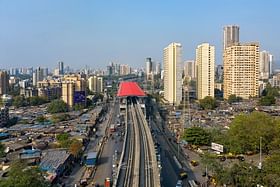The Mumbai Metropolitan Region Development Authority (MMRDA) has partnered with the World Bank to foster the advancement of sustainable transportation and transit-oriented development (TOD) within the Mumbai Metropolitan Region (MMR).
The collaboration was confirmed on Saturday (10 June) by the authority, as per Indian Express report.
The MMRDA has formulated TOD policies and regulations for the Mass Rapid Transit System (MRTS) in the MMR, which are expected to be approved soon.
TOD is a widely embraced approach that promotes development along public transit corridors, leading to more efficient land utilisation.
It is considered a sustainable alternative to urban sprawl, maximising the use of existing infrastructure and optimising transit networks.
In May 2017, the Ministry of Housing and Urban Affairs (MoHUA) introduced the National Transit Oriented Development policy, serving as a guiding framework for states and cities adopting TOD as a strategy for urban growth.
This policy defines TOD as a means of integrating land use and transport planning to establish well-designed, sustainable urban centres interconnected with high-quality transit systems.
Mumbai’s Transit Infrastructure Transformation
Mumbai MMR is currently undergoing a significant infrastructure transformation with the objective of enhancing its transit systems and establishing an integrated network.
This comprehensive network includes the Metro, suburban rail, monorail, high-speed rail, along with road network projects such as the Mumbai Trans Harbour Link (MTHL).
Over the past three decades, Mumbai’s continuous growth has extended into the MMR, leading to the expansion of smaller cities and towns surrounding the main city.
Bringing together these projects will provide seamless connectivity among the extended regions and the mainland.
Moreover, this extensive network is expected to bring significant benefits to the ambitious economic growth targets, as it unlocks immense potential for the regions surrounding these transit networks.
The MMRDA’s objective is to leverage the impacts of these essential transportation projects and establishment of surrounding growth centres, for driving sustainable urban development in the region.
TOD Approach For Region’s Growth
With an eye towards the future potential, several localities of the MMR are being developed — such as Karjat, Kasara and Shahapur in the extended Central Mumbai suburbs.
Additionally, industrial and commercial setups have been attracted to locations like Ambernath, Badlapur, Ambivali, and Dombivli in the Thane district.
The state government has identified Bhiwandi and Navi Mumbai as upcoming logistic hubs.
Many areas along the proposed metro networks in MMR are witnessing a surge in residential demand and significant improvements in the real estate sector.
In order to tap into the potential of these growing areas, Transit-Oriented Development (TOD) policies will be implemented to facilitate organised development, optimal planning and land utilisation, creating pedestrian-friendly built environments while maximising access to the public transit infrastructure.
These policies, once established, will stimulate both redevelopment projects and the development of new areas in the MMR.
As part of the TOD policy, the MMRDA will impose a certain premium on development activities near the influence area.
This premium will serve as a revenue source for the authority, enabling them to finance large-scale infrastructure initiatives.
The partnership with the World Bank, harnessing their expertise, and the growing demand along the extensive transit network is positioned to have a pivotal impact on transforming the region.
The partnership aims to address key challenges in Mumbai — such as redevelopment, creation of affordable and accessible housing options, along with vibrant community spaces, such as around the metro stations.
These collective efforts are also aimed to significantly reduce the city’s carbon footprint, and will allow well-coordinated planning of investments and land use management for the region’s growth.


